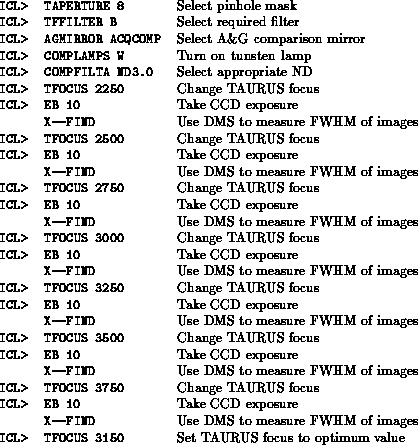
Previous: Setting fieldsize
Up: Setting up
Next: Telescope focus
Previous Page: Setting fieldsize
Next Page: Telescope focus
TAURUS is focussed using one of two aperture masks mounted in the aperture wheel. One mask provides a matrix of large (200 micron ) regularly spaced pinholes, whilst the other mask provides a single laser--drilled small (20 micron ) pinhole. The former is useful for coarse focussing, whilst the latter is useful for fine focusssing and for assessing the on-axis image quality. With the f/4 camera, the 20 micron pinhole projects to 7 micron on the detector, whilst with the f/2.1 camera the pinhole projects to about 7 micron, both of which are much less than the CCD pixel size.
The procedure is first to check the coarse focus by selecting the matrix mask, and illuminating it using the tungsten lamp in the A&G unit. Take a series of exposures with different values of the camera focus, and measure the FWHM of the images. Then use pencil and graph paper to determine the optimum focus.
It should be possible to bracket the best focus; as the camera position is changed the image quality should first improve as the position of best focus is approached, and then start getting worse again once the position of best focus is passed.
For each exposure use the TFOCUS command to set the TAURUS focus. Then take an exposure using the EXPOSE command. Finally measure the FWHM of one of the pinhole images using the DMS. The DMS functions X--FIND and Y--FIND can be used for this purpose.
The camera can be moved through a total range of 6000 micron. With the f/4 camera, the values of camera focus with the B,V,R and I filters are 3150, 2950, 2850, 2800 respectively. An error in the camera focus of +- 200 changes the FWHM by less than about 5 per cent. So a typical focus run might involve taking a series of exposures covering the range 2250 to 3750 in steps of 250.
An example set of commands to carry out this procedure might be as follows. All the commands are issued from ICL, except for X--FIND which is issued from the DMS keyboard. Note that the actual procedure used will depend, for example, on the name of the detector being used.

If it is not possible to go through focus within the allowed range of camera movement, it may be necessary to adjust the capstans on the CCD. Note that increasing the value of the camera focus has the effect of moving the camera down, out of the instrument; thus, if the position of best focus lies above the allowed range of camera movement, it will be necessary to raise the detector. If this still doesn't help, and the image quality is poor, check that the correct spacer box and spacer ring have been used between TAURUS and the CCD. The f/4 camera requires a black spacer box, the f/2.1 camera doesn't. The spacer ring should have a thickness of ? mm.
Once the approximate focus has been measured, fine-focussing can be carried out by selecting the laser-drilled pinhole and repeating the above procedure.
Finally, it is worth noting that the position of best focus is slightly wavelength-dependent (see section 18), Thus, if the best image quality is required, it will be necessary to measure the position of best focus at each observing wavelength.